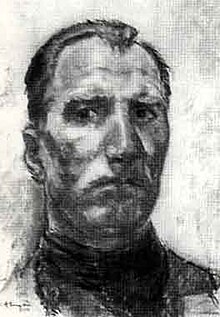Călin Alupi (July 20, 1906 – September 19, 1988) was a Romanian Post-Impressionist painter, cited along with Corneliu Baba and Alexandru Ciucurencu as one of the greatest painters of the period amongst his countrymen.

He was born in Vancicăuții Mari, at the time in the Bessarabia Governorate, the son of two peasants, Teodor and Antonina Alupi. His father died in World War I, while fighting in Galicia as a soldier in the Imperial Russian Army.[1][2] Călin Alupi attended high school in Șendriceni, where his desire to paint was sparked at age 13 by his teacher, Nicolae Popovici Lespezi. In 1925 he entered the School of Fine Arts in Iași, where he was mentored by Ștefan Dimitrescu. By 1933 he began to exhibit his work, both individually and with other painters. When Nicolae Tonitza was commissioned to decorate the Durău Monastery, he chose Alupi, together with Corneliu Baba and Mihai Cămăruț to be part of his group of apprentices.[1]
After World War II broke out, he was conscripted in 1940 and posted to the front line, where he remained until 1944, when he returned by foot from Odessa. In 1945, lieutenant in reserve Alupi was awarded the Order of the Crown of Romania, Knight rank. In 1947 he became a professor at the School of Fine Arts in Iași and married Sanda Constantinescu Ballif. Their daughter, Antonina, who was born in 1950, also became a painter. He died in Iași, at age 82 and was buried in the city's Eternitatea Cemetery.[1]

In March 2010, the City Hall of the 5th arrondissement of Paris hosted the Sinceritate Exhibition, the first large exhibition of Călin Alupi in France, with about 100 paintings presented.
References edit
- ^ a b c "Călin Alupi – Biografie". www.alupi.com (in Romanian). Retrieved September 17, 2023.
- ^ "Călin Alupi". /www.encyclopedia.com. Retrieved September 17, 2023.
External links edit
- The Sinceritate Exhibition in Paris, March 10–27, 2010
- Atelier Alupi art school in France Created by Călin Alupi in 1983, it provides art courses and painting workshops in Paris and other spots in France.